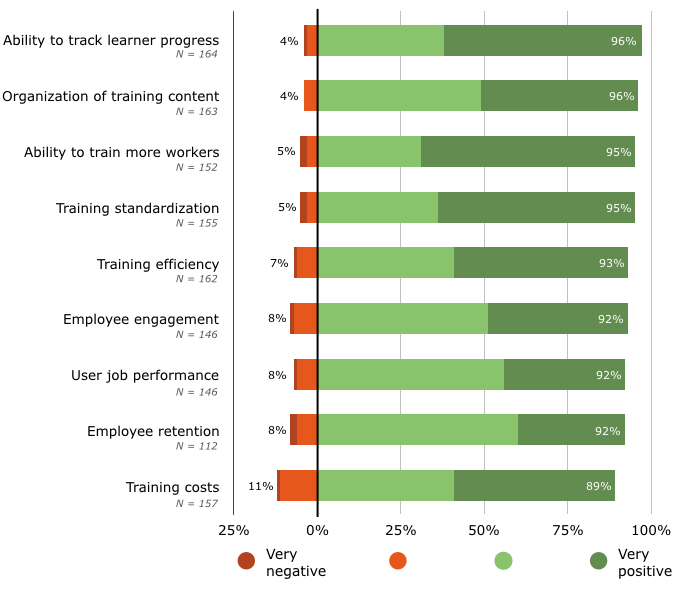Fast. This is the single word that sums up our current world.
Everything is fast. Running is the new walking. If you dare to pause for one second too much you get left behind. Do you know any successful person or organization that doesn't keep up with their fast-changing environment? I honestly doubt it.
Technology is the accelerator of this fast-paced, ever-changing world, and it affects every aspect of our lives. We can't stop it. And we shouldn't. We must embrace technology and use it as the powerful tool it is to reach success, both personal and professional.
Being able to adapt to new situations and learn how to navigate between forever-old needs and brand new technologies — and do this fast — is a 21st-century skill that everyone should possess. Businesses are already looking for this skill in every employee, whether on the payroll or not yet there.
Learning at work needs to happen as fast and as thoroughly as possible. People have the knowledge, but only technology can spread it among everyone in an organization. Learning management systems are almost always a part of this technology. Businesses that use a corporate LMS for workplace learning and development are one step ahead of those that don't and their employees productivity is higher.
LMS software meet corporate learning needs
Software Advice, a Gartner company, provides detailed reviews and extensive research of software applications, including learning management systems. They surveyed nearly 200 corporate LMS users involved in creating or managing their organization's training programs. These L&D professionals were asked about how they used the system, how were their training environments like, what benefits and challenges they've experienced, and what future LMS investment plans they've considered.
Their report is sure worth a read.
It states that most LMS users take a blended approach to employee training, combining instructor-led and self-administered courses. It also states that cloud-based LMSs slightly outnumber on-premise systems and that desktop computers are still the preferred devices for accessing training courses. For more about these online training aspects, be sure to check the report in its entirety.
But the most important finding of this report is that the great majority of users say their LMS positively impacts the success of their organization.
It was anticipated that most users would benefit from their LMS system, but it was still surprising to see the overwhelmingly positive results of our survey. A majority of those surveyed said these systems are a significant investment. However, nearly most of them (89 percent) saw the benefits their LMS had on overall cost of training. An even better 92 percent said employee retention improved after implementation. This tells us LMS tools are meeting the needs of the buyer.
Brian Westfall, Senior Market Research Associate
How an LMS positively impacts business training
Going a little deeper into data, the Software Advice report shows exactly how a learning management system positively impacts workplace training:

Let's take them one by one:
-
Ability to track learner progress — 96%
It's very hard for one instructor to keep track of everything going on in the learning process of one employee: his/her already available knowledge, how many and what kind of learning modules they have to pass in order to master the skill they are trained for, what assignments are due and until when, and so on, and so forth. And instructors have to do this for tens of employees at once, if not more.
So no wonder an LMS makes their lives easier. The analytics and reporting tools provide valuable data for course administrators, in real time. They can see who did what in just a matter of clicks, so they can adjust their instruction and better — and faster — determine the following steps to be taken for each learner.
-
Organization of training content — 96%
The other top advantage of using an LMS for workplace training is that it allows instructors to keep all training materials organized. Anyone who has ever learned something knows that the amount of documentation can get overwhelming.
A learning management system offers a clear and structured way to organize and navigate through all documents, be those text files, images, videos, or any other multimedia content file. On top of that, it reduces the risk of having multiple versions of the same file in different places, and it makes it easy for instructors to keep the training content constantly updated.
-
Ability to train more workers — 95%
Another great benefit of using an LMS is its scalability. With traditional training, a growing number of trainees demand a growing number of instructors and other resources as well. But this is not necessarily the case with a company LMS.
Whether you start with 15 learners and grow to 70, or with 500 and grow to 2,500, a training program managed through an LMS can and will work the same, without many extra resources. And as an added benefit, the employees don't even have to work on the same premises — they can easily belong to geographically dispersed teams.
-
Training standardization — 93%
Employees are different and learn differently, but this doesn't mean they shouldn't know the same things if they perform similar types of jobs. In fact, if we're talking about a corporation with offices in different countries, cultural differences could highly affect training outcomes.
By using a corporate learning management system the L&D department can make sure all employees are on the same page in terms of workplace training regarding their specific jobs, no matter where they are located. Everyone that attends a certain training course will learn the same information, and only a learning management system can ensure a satisfactory level of training standardization.
-
Training efficiency — 93%
Traditional training responds more to the needs of the instructor and less to the actual needs of learners. Having to be physically present in a training room at fixed schedules isn't always easy for busy employees.
But learning management systems — whether they are used exclusively or as just a part of the company training strategy — put more power into learners' hands. It's easy for instructors to respond to different learning styles and let employees choose how, where and when they learn. Also, when employees are empowered to go through a training course at their own pace, they pay more attention to the learning materials and therefore pass the course with better results, and sometimes even faster.
-
Employee engagement — 92%
Again, when employees feel they have no power over their personal learning process they don't get very excited about attending any training course. And when they also have to follow boring presentations packed-full with information, their engagement rates drop considerably. A traditional training room may have the advantage of face-to-face interaction, but it also has limited resources to raise the interest of all learners at the same time.
An LMS on the other hand, provides plenty of options for instructional designers to create engaging online courses. Gamification, learning scenarios, and simulations are just a few examples of training techniques that are equal to interactive learning activities. Being able to receive instant feedback, along with using the collaboration tools, also contributes to high employee engagement rates.
-
User job performance — 92%
The whole point of training is to fill the gap between A — what an employee knows about his/her job, and B — what that employee could know better. Getting better at one's job requires constant work and learning. And the gap between A and B shrinks faster when training is perfectly aligned with employees' learning objectives.
All the learning resources in an LMS should be available anytime, so that trainees could easily access them, at the point of need. When employees get the right piece of information just when they need it most, they can immediately apply what they learn and therefore better perform their job.
-
Employee retention — 92%
Long gone are the days when long tenure in one company was possible and highly regarded. Today the employment world is more rapidly shifting. Employees know they can't fall asleep on their careers. They can't afford to have one year of experience repeated ten times; they need ten years of real work experience — no matter if they get it from one or from ten different employers. And the only way to do that is to constantly learn and develop professionally.
That's why employees put so much value on continuous learning opportunities at work. Companies that provide these professional learning opportunities and use an LMS for training employees respond to the reality of the working world today. When people can learn and get better at their jobs, they tend to stay more with one employer, so companies witness higher employee retention rates.
-
Training costs — 89%
Implementing a new learning management system and then getting all users up to date and up to speed with everything they can achieve with it is surely a significant investment. But it's definitely worth it, as a business LMS can actually save training costs in the long run.
Companies that use a learning management system for workplace training don't have to accommodate trainers in different cities, don't have to pay for training room facilities, don't need to print millions of sheets of paper, and generally avoid all sorts of other costs. Not only that, but employees have better training results, improve their performance, and actually contribute to higher company profits.
Closing thoughts
Of course implementing and fully adopting a new software for training comes with some challenges. The Software Advice research found that a difficulty in learning how the system works, technical bugs, and integrations with other systems as the main problems related to this.
But there is more than one solution for each of all these challenges. And the above nine advantages definitely tip the scale in their favor and make the use of an LMS for workplace training worthwhile.







